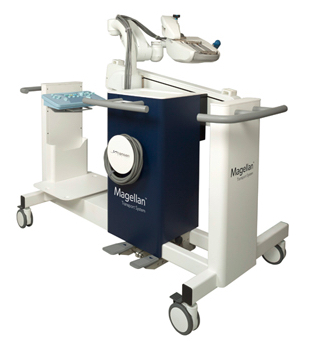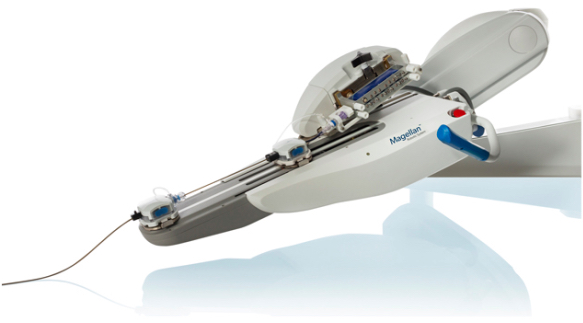The Magellan Robotic System, an advanced technology that enables precise steering of guide wires and proprietary robotic catheters through complex anatomy during minimally invasive, endovascular procedures, is designed to offer predictability, precision, and catheter stability as physicians navigate inside blood vessels and deliver therapy.
Enlarged prostate, or benign prostatic hyperplasia (BPH), affects more than 50 percent of men over age 50 and can lead to dysfunction associated with the bladder and urination. The Magellan Robotic System facilitates a new treatment for BPH called “embolization,” in which the controlled blockage of arteries feeding the prostate works to shrink the gland and improve symptoms, with minimal risk of erectile dysfunction, urine leakage, or incontinence.
Holy Name Medical Center in Teaneck, New Jersey, reports that its physicians are the first in the U.S. Northeast — and one of only eight hospitals nationwide — to use the Magellan system, enabling them to perform complex vascular procedures with extraordinary precision and speed. Physicians may also perform Magellan procedures while seated at a remote console, away from radiation. The Magellan Transport System makes the Magellan robotic arm mobile and adds flexibility to an intravascular robotics implementation.
Physicians may also perform Magellan procedures while seated at a remote console, away from radiation. The Magellan Transport System makes the Magellan robotic arm mobile and adds flexibility to an intravascular robotics implementation.
Magellan’s manufacturer, Hansen Medical, Inc., of Mountain View, California, says the company’s founding vision was that of creating a new generation of advanced medical robotics that would empower and protect physicians while providing enhanced care for patients.
Hansen Medical exhibited the Magellan Robotic System at the 42nd Annual VEITHsymposium, held Nov. 17–21 in New York City, conducting demonstrations of the system and the related family of Magellan Robotic Catheters, including the Magellan 6Fr, 9Fr and 10Fr catheters.
The 5-day VEITHsymposium provided vascular surgeons, interventional radiologists, interventional cardiologists and other vascular specialists with an opportunity to learn about what is new and important in the treatment of vascular disease. “We are delighted to be exhibiting at this year’s VEITHsymposium, and are particularly pleased with the robust representation of intravascular robotics on-podium,” said Cary Vance, Hansen Medical’s President and Chief Executive Officer. “We are further excited to demonstrate our full complement of Magellan Robotic Catheters, particularly our latest addition, the Magellan 10Fr.”
Holy Name says that in many cases, Magellan provides a nonsurgical alternative for patients who either prefer to avoid endovascular surgery, or whose prior surgery was not successful. Procedures using the Magellan technology are performed at Holy Name’s Interventional Institute, a state-of-the-art facility that is regionally recognized for minimally invasive therapies and successful outcomes in complex cases.
 Interventional radiology (IR) is a rapidly growing area of medicine, under the direction at Holy Name of John Rundback, MD, an international leader in the field. With IR, novel imaging techniques are employed in order to “see” inside the body while guiding catheters and other very small instruments through the blood vessels and other pathways to the site of an abnormality. IR enables patients to receive treatment for a variety of medical disorders without surgery. Most procedures can be performed on an outpatient basis or require only an overnight stay at the Interventional Institute. General anesthesia is seldom used, and risk, pain, and recovery time are often significantly reduced.
Interventional radiology (IR) is a rapidly growing area of medicine, under the direction at Holy Name of John Rundback, MD, an international leader in the field. With IR, novel imaging techniques are employed in order to “see” inside the body while guiding catheters and other very small instruments through the blood vessels and other pathways to the site of an abnormality. IR enables patients to receive treatment for a variety of medical disorders without surgery. Most procedures can be performed on an outpatient basis or require only an overnight stay at the Interventional Institute. General anesthesia is seldom used, and risk, pain, and recovery time are often significantly reduced.
However, Hansen Medical notes that, according to the US. Environmental Protection Agency of Radiation Protection Programs Home Page; Health Effects, image-guided medical procedures using interventional fluoroscopy, while growing rapidly, are also the leading source of occupational ionizing radiation exposure for medical personnel. Magellan’s remote workstation allows physicians to control robotic catheters and guide wires while seated away from the radiation field. The added distance can reduce radiation exposure to the physician by as much as 95% in complex endovascular procedures, a point noted in a presentation entitled “Robotic Catheter Assistance: The Relationship on Radiation Exposure” by Barry Katzen, MD, at Charing Cross International Symposium, London, in April 2015.
“Holy Name Medical Center is pleased to expand its range of robotic services with the addition of the new Magellan Robotic System,” says Michael Maron, President and CEO of Holy Name Medical Center. “With the leadership of our internationally recognized interventional radiology specialists, this new platform will provide the region with the most cutting-edge intravascular technology for nonsurgical, minimally invasive procedures.”
The key to the Magellan Robotics System is its image-guided navigation: Catheters are controlled robotically by the physician and are highly maneuverable, able to rotate 360 degrees and to bend 180 degrees in any direction. The flexibility leads to shorter procedure times and greatly reduced side effects compared with open surgery. Stenting and other endovascular procedures performed with Magellan can quickly restore blood flow and, in acute cases, potentially save a patient from limb amputation.
“We are able to do peripheral vascular procedures with this new device because it allows us to place catheters with pinpoint precision and accuracy,” says Dr. Rundback. “The robotic system and robotic catheter give us maximum flexibility and control through a remote workstation.”
Dr. Rundback performed his first procedure using the Magellan on a 64-year-old man with critical limb ischemia, or severe blockages of the leg arteries, accompanied by severe pain. Because the patient had very twisted blood vessels and had undergone previous procedures attempting to correct the condition, he was not a good candidate for either conventional surgery or traditional catheter techniques to clear the blockages. However, the Magellan robot allowed the Interventional Institute physicians to successfully navigate the many turns in the patient’s arteries, unblocking the vessels and thereby eliminating the pain he had been living with for years.
Currently, in addition to the benign prostatic hyperplasia therapy outlined above, the Magellan device is approved by the U.S. Food and Drug Administration (FDA) for use in treating peripheral arterial disease, or PAD (a blockage of the arteries in the body), liver cancers, enlarged uterine fibroids, and significantly enlarged prostates that have not responded well to other treatments. The Peripheral Vascular Disease category covers a number of diseases affecting the blood vessels outside the heart and brain, often resulting in a narrowing of vessels that carry blood to the legs, arms, stomach or kidneys.
Uterine fibroids are non-cancerous tumors in or around the uterus. The most common benign tumors in women, they can cause heavy menstrual bleeding, pain, and pressure on the bladder or bowel. The Magellan Robotic System allows precise positioning of catheters through which physicians can deliver treatment to block the blood supply and estrogen that have been feeding the fibroids, thereby resolving symptoms and preventing a total hysterectomy.
Liver and other cancers can be treated with a minimally invasive procedure that cuts off the blood supply feeding a tumor. Treatment for head and neck cancers and gynecologic cancers that are unresponsive to other treatments are also being explored with the Magellan Robotic System.
For more information about procedures that can be performed with the Magellan Robotic System, call Holy Name’s Interventional Radiology Department at 201-833-7268 or visit:
http://holyname.org/magellan
For more information about the Magellan Robotic System, visit:
http://www.hansenmedical.com/us/en/vascular/magellan-robotic-system/product-overview
Sources:
Holy Name Medical Center
Hansen Medical Inc.
42nd Annual VEITHsymposium

